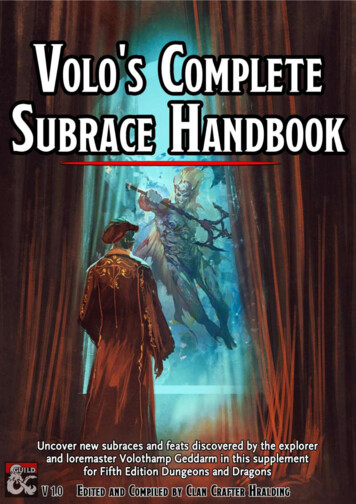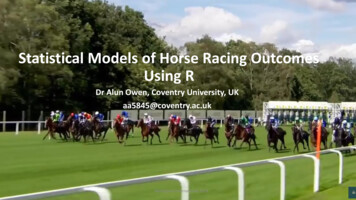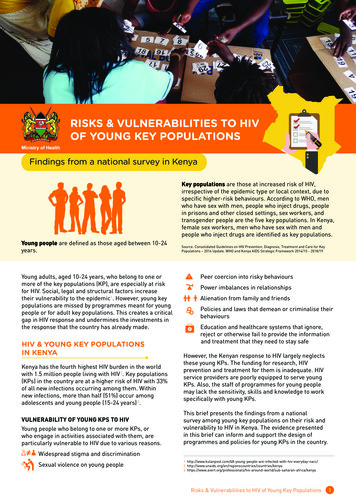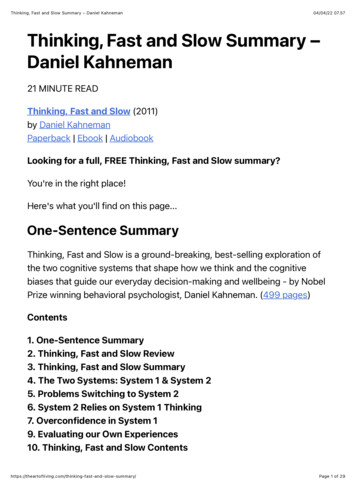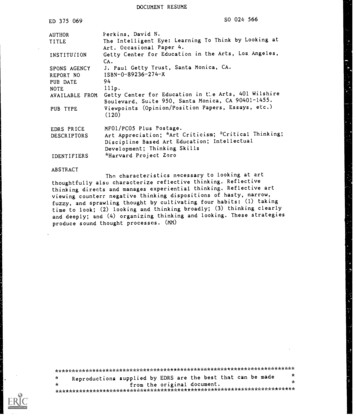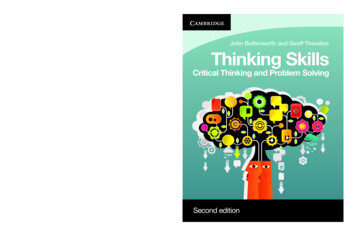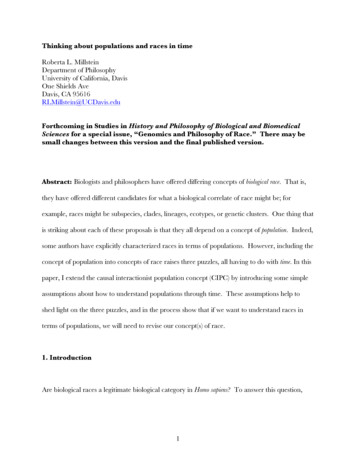
Transcription
Thinking about populations and races in timeRoberta L. MillsteinDepartment of PhilosophyUniversity of California, DavisOne Shields AveDavis, CA 95616RLMillstein@UCDavis.eduForthcoming in Studies in History and Philosophy of Biological and BiomedicalSciences for a special issue, “Genomics and Philosophy of Race.” There may besmall changes between this version and the final published version.Abstract: Biologists and philosophers have offered differing concepts of biological race. That is,they have offered different candidates for what a biological correlate of race might be; forexample, races might be subspecies, clades, lineages, ecotypes, or genetic clusters. One thing thatis striking about each of these proposals is that they all depend on a concept of population. Indeed,some authors have explicitly characterized races in terms of populations. However, including theconcept of population into concepts of race raises three puzzles, all having to do with time. In thispaper, I extend the causal interactionist population concept (CIPC) by introducing some simpleassumptions about how to understand populations through time. These assumptions help toshed light on the three puzzles, and in the process show that if we want to understand races interms of populations, we will need to revise our concept(s) of race.1. IntroductionAre biological races a legitimate biological category in Homo sapiens? To answer this question,1
biologists and philosophers have had to characterize “biological race.”1 Such characterizationsdiffer, but notably, the concept of population plays a central role in many of them. For example: Races as genetically different – “A geneticist can define races as populations that differ fromeach other in the frequencies of certain genes” (Dobzhansky 1941, 162; emphasis added). Races as subspecies – a race is “a geographically localized subdivision of the species, whichdiffers genetically and taxonomically from other subdivisions of the species [and is].composed of a number of genetically distinct populations (Mayr 1942, 106; emphasisadded). Races as lineages – a race is “a distinct evolutionary lineage within a species” (Templeton1998, 632), but “recurrent genetic interchange among Old World human populations”would mean that human races do not exist (Templeton 1998, 636; emphasis added). Races as clades – “races are ancestor-descendant sequences of breeding populations, orgroups of such sequences, that share a common origin” (Andreasen 1998, 200; emphasisadded). Races as ecotypes – races are “local populations adapted to particular environments” (Pigliucciand Kaplan 2003, 1161; emphasis added).By specifying biological race concepts, I mean to distinguish biological concepts from “commonsense” or “social”concepts of race. This is not to say that the biological concepts are somehow asocial, but rather that such conceptshave specifically sought to identify a biological correlate for race.12
Races as populations – ‘race,’ in its current U.S. meaning, is a proper name for a particularset of human populations (Spencer 2014a). Races as population groups – a race is a group of populations that exhibits a distinctive patternof genetically transmitted phenotypic characters that corresponds to the group’sgeographical ancestry and belongs to a biological line of descent initiated by ageographically separated and reproductively isolated founding population (Hardimonmanuscript).In this paper, I will neither take a stand on which biological race concept, if any, is viable, nordiscuss the question of whether, given a defensible concept (or concepts) of race, races exist inHomo sapiens. Rather, I examine three puzzles that result from including a population concept ina race concept:1. Population membership at a time: Can a person be a member of more than one population ata time, as we would say that a person can be a member of more than one race?2. Forward-looking vs. backward-looking concepts: Is “race” a “backward-looking” concept (i.e.,looking to the past), and is “population” a “forward-looking” concept (i.e., looking to thefuture)? If so, have confusions been introduced by characterizing “race” in terms of“population”?3. Status of genetic clusters: Can genetic clusters (see, e.g., Rosenberg et al. 2002, 2005), theresult of interactions from different points in the past, be understood as delineations of3
populations or races or both?Note that all three puzzles involve time. Among race scholars, Lisa Gannett has usefully drawnattention to the importance of time in thinking about races and populations; I thus use her workas a springboard. She argues that thinking about time supports the view that there are multiplelegitimate concepts of “population,” depending on research context (Gannett 2003). Forexample, one researcher might wish to predict the future composition of a particular population’sgene pool, given the population’s current size, genetic composition, breeding structure, and ratesof mutation and migration. Such a researcher, Gannett suggests, would use a forward-lookingpopulation concept, relying on breeding units to delineate the population; the organisms that areinterbreeding will determine the future gene pool, regardless of their past origin(s). Anotherresearcher might want to compare adaptive differences among the same organisms – organisms,let us suppose, that have origins in different environments. Such a researcher, Gannett suggests,would use a backward-looking population concept, relying on ancestral relations to delineate thepopulation; the researcher would not want to lump together in the same population organismsthat had undergone different selection processes, even if they were now interbreeding. Thus, onGannett’s account, there are at least two different population concepts that a researcher mightuse, depending on the research question she was seeking to answer, one forward looking (usinginterbreeding as a criterion) and one backward looking (using ancestral relations as a criterion).2In a paper on the use of race in pharmacogenetics research, Gannett further states:Baum (1998) makes similar claims with respect to species concepts, distinguishing between a forward-lookinginterbreeding species concept and a backward-looking genealogical species concept.24
Genetic clustering tells us something about the ways in which individual genomes have beenshaped by past, even long past, reproductive choices and environments. But what is it tosay, further, that these genetic clusters themselves represent biological groups whosecomponent individuals share “genetic ancestry” or a common “ancestral geographicalorigin”? Which ancestors (matrilineal, patrilineal, recent, remote)? Which geographicallocations (country, city, village, riverbank, valley, continent, island)? Research contextdetermines the geographical scale or historical period of interest (2005, 1237-8; emphasisadded).Here, Gannett seems to be suggesting that there is no privileged point in time (and no privilegedplace) that would univocally determine a person’s “race.”Contrary to Gannett’s pluralism about populations, Millstein (2009, 2010a) defends a monistpopulation concept: the causal interactionist population concept (CIPC).3 In what follows, Iextend (and slightly modify) the CIPC in order to show more explicitly how it incorporates time,using some relatively simple assumptions about how to understand populations through time. Inlight of this elaboration, I agree with Gannett that there is no privileged point in time that wouldunivocally constitute a person’s “race,” but disagree with her claim that looking-forward andlooking-backward require different concepts of population. I then seek to shed light on the threepuzzles I outlined above.However, it is a defeasible monism (Millstein 2010b). Note that I will simply presume the CIPC here; see Millstein(2009, 2010ab, 2014) for a defense. I recognize that the CIPC does not capture all biologists’ utterances of the term“population” in ecological and evolutionary contexts, but it avoids difficulties encountered by other populationconcepts, e.g., difficulties with describing and predicting evolutionary dynamics. See Barker and Velasco (2013) andStegenga (2014) for more recent defenses of population pluralism, discussion of which would take me afield from thearguments of this paper.35
A note before proceeding: The authors cited above do not generally specify what they mean by“population.” Or they default to population genetics’ definitions of the term, which arethemselves not clear and whose ambiguity raises various problems (Millstein 2009).4 Thisambiguity necessitates the use of an articulated and defended conception of “population”; thus, Iuse the concept that I have previously defended, the CIPC. I suspect that it would possible tomake similar points with an alternate concept of population (e.g., the population-as-demeconcept discussed in Millstein 2014), but I have not fully explored that possibility, and I do notexplore it here.2. Incorporating Time into the Causal Interactionist Population Concept (CIPC)I begin by outlining the basic elements of the CIPC (see Millstein 2010a for further details).According to the CIPC, in ecological and evolutionary contexts5 populations consist of at leasttwo conspecific organisms who, over the course of a generation, are actually engaged in survival orreproductive interactions, or both. Reproductive interactions include both unsuccessful andsuccessful matings (interbreeding), as well as offspring rearing. Survival interactions are almost asbroad as Darwin’s “struggle for existence,” including competition for limited resources as well ascooperation. Social interactions are not a separate category, but may fall into either or both ofthe other two categories; social interactions that do not affect survival or reproduction are notrelevant evolutionarily or ecologically.4See also Kaplan et al. (THIS ISSUE) for discussion of a race debate where problems are caused by a failure to offera defensible way of recognizing biologically meaningful populations.5 That is, the CIPC makes no claims about the concept of population in other domains, where it will likely differ atleast in some if not many respects. My implicit claim here is that the proposed biological notions of race arise inecological and evolutionary contexts, a claim that I take to be uncontroversial.6
The CIPC further specifies that the boundaries of the population are the largest grouping wherethe rates of interaction6 are much higher within the grouping than outside. Thus, organismslocated in the same spatial area (including recent migrants) are part of the population if and onlyif they are interacting with other conspecifics. If a later grouping is causally connected bysurvival and/or reproductive interactions to an earlier grouping, then it is the same population,although fusing, splitting, and budding are in this essay newly introduced as exceptions to thisgeneral rule (see discussion below). Thus, populations are continuous through time even asorganisms die and new ones are born, just as organisms themselves are continuous through timeeven as cells die and new ones are born.To understand populations through time, we need to know how populations begin (are “born”),how populations end (“die”), how to handle population splitting and “budding,” and how tohandle populations fusing. The CIPC specifies that new populations generally begin withinteracting founders who are no longer interacting with others in the population, as might occurwith geographical separation, and that populations end with the death of the last organism in thepopulation, if not sooner (Millstein 2009).7 But more needs to be said. What follows are somesimple and straightforward proposals for thinking about populations through time. These areintended to be uncontroversial and indeed unsurprising given longstanding biological practice.8(What I hope to be more surprising are the consequences of accepting these proposals, as describedin section 3).Jim Griesemer has suggested to me that the strengths of interactions, and not just their rates, might be important forthe constitution of a population (consider, for example, a rare reproductive event that nonetheless contributes newand important alleles to the population). This is a topic worthy of further consideration; I find the suggestionappealing, although I worry about how one would measure relative strengths.7 Lack of interaction between organisms might also be the end of a population; other ways are shown below.Previous incarnations of the CIPC are not committed to any particular way that individual populations cease toexist, only that they, like individual organisms, eventually do cease to exist.8 See also Sober (2000, 157-159), who makes similar points.67
2.1. Populations fusing. If the organisms in one population a begin interacting with theorganisms in a second population b, they will form a new population c.9 (See Figure 1). Thisfollows straightforwardly from the core interactionist aspect of the CIPC, which relies on survivaland reproductive interactions to delineate populations. Populations a and b cease to exist whentheir constituent organisms begin interacting, and a new population c, which could notreasonably be identified with either a or b and having a new dynamics and trajectory, is formedfrom the interactions of the former members of a and b.2.2 Population splitting and budding. Again focusing on interactions, if a significantfraction of the organisms in one population a cease interacting with a significant fraction of therest of the organisms in population a, they will form two new populations, b and c. This is asplitting of population a; population a ceases to exist. (See Figure 2i). If, on the other hand, only aNote fusing necessitates a qualification of the “continuity” aspect of the CIPC from what Millstein (2009, 2010a)previously characterized; that is, this is a case where even though later groupings are causally connected by survivalor reproductive interactions to earlier groupings, they are not the same population.98
small fraction of the members of a cease interacting with the other members of a, we say that anew population b has budded off from population a, with population a persisting after thebudding. (See Figure 2ii).10 In both splitting and budding, one population becomes two. In thebudding case, the original population persists, but it does not in the splitting case. Obviously,there is a continuum between splitting and budding. The term “budding” can be reserved forthe cases where a truly small fraction has separated off, leaving intermediate, uncertain cases tobe considered a “splitting.” The reason is that any sort of substantial separation would mean thatthe new groupings would have a substantially different character (dynamics and trajectory) fromwhat existed before, meaning that the original population has ceased to exist. Still, thepopulations are related genealogically; for either splitting or budding, we would say that the newpopulations are descended from the original populations.Note that splitting and budding necessitate a qualification of the “continuity” aspect of the CIPC from whatMillstein (2009, 2010a) previously characterized; that is, these are cases where even though a later grouping iscausally connected by survival or reproductive interactions to an earlier grouping, it may not be the samepopulation.109
2.3 Limited migration. When an individual organism ceases interacting with the members ofone population a and begins interacting with the members of a different population b, it ceasesbeing a member of a and becomes a member of population b. (See Figure 3). We would still saythat the individual was formerly a member of a; the individual may have also been descendedfrom a. This has been part of the CIPC all along, and is a standard way of handling migration inecology and evolution. I emphasize it here in order to highlight that an organism’s membershipin any given population is always relativized to time. That is, we should say that an organismwas a member of population a during time span x and a member of population b during timespan y.10
2.4 Multiple migrations. Consider the two populations depicted in Figure 3. Suppose thatinstead of rare migration between the populations, there were frequent migrations between thegroupings. In that case, there would be one population, albeit one patchy population (Millstein2010a), rather than two. (See Figure 4). Because of the interactions between the patches, thefates of the two patches are linked. For example, an advantageous allele arising in one patch mayspread into the other patch and become common in the population as a whole. Of course, thereis linkage between the populations represented in Figure 3 as well, but to a much lesser degree;the two populations linked by infrequent migration/interaction are a metapopulation (Millstein2010a). As with the distinction between splitting and budding, there is no sharp dividing linebetween metapopulations and patchy populations.11
3. Shedding Light on the Three PuzzlesThese simple, straightforward assumptions help answer our three puzzles, as follows.3.1. Population membership at a time. Can a person be a member of more than one population, aswe would say that a person can be a member of more than one race? In short, no. As discussed in Section2.3, a person is a member of only one population at a time – the one they are currentlyinteracting with. When they stop interacting with the members of one population and begininteracting with the members of another, they leave the former and join the latter. Thus, aperson can be formerly a member of one population and currently a member of a new population.The exception is when many such people are interacting between what would otherwise beseparate populations. As discussed in Section 2.4, this is in fact one patchy population, so theperson in question is still a member of just one population at a time.12
More precisely, if a person begins interacting with a new population, then that person was amember of population a during time span x and is a member of population b during time span y.An offspring of an individual who migrated from a to b, is descended from population a but is not amember of population a. Similarly, in cases of splitting or budding, offspring of members of thenew population are descended from the original population a but are not members of population a.In these ways, population membership is relativized to time.11My discussion here might prompt some to think about various possible degenerate cases. Forexample, suppose a person is going back and forth between populations, e.g., leaving apopulation to bring food for sale to another population and then returning back to the originalpopulation, further supposing that they are the only person, or one of a small number of people,doing so. (Since again, if many such people were engaging in such interactions, there would beone patchy population, not two separate populations). Assuming that the majority of the person’sinteractions are with the original population, the person’s fate is more tightly linked with theoriginal population, thus making that the population to which they belong. On the other hand,suppose the person alternately interacted with the two populations for six months each, so thatone might think that there was no reason to say that the person was more a member of onepopulation than the other. Although it might seem counter-intuitive, relativizing to time seemsto be the answer here; the person is a member of the first population for a time, then a memberof the second population for a time (and not a member of the first), and then upon re-interactingwith a first population again, becomes a member of that population for the subsequent timeperiod. Finally, we might consider the case of someone who is interacting with more than onepurported population at the same time. It is difficult to come up with examples that would not11Note that this is different from delimiting a population by a certain time period.13
also imply other interactions between the two groupings, making them one patchy populationrather than two: the dropping of a nuclear bomb, the creation of a dump site, or the building of anoisy airport. Perhaps there are such cases, but I suspect they are rare. Note that the CIPC isnot meant to be a definition spelled out in terms of necessary and sufficient conditions, withcounter-examples serving as defeaters. Rather, it is a concept that can be applied to variouscases, i.e., various groupings of organisms in nature,12 fitting them more or less well. Biology ismessy and no concept can or should correct for that.If we want to maintain the claim that a person can be of more than one race while incorporatinga population concept into the race concept, we should likewise be clear about which populationthey are currently a member of and which populations they are descended from – and when. Todo otherwise is to potentially confuse past population membership with present. And we wouldneed to reconcile the fact that someone can change the population that they are a member of(i.e., are a part of), but we generally don’t think that someone can change their race.3.2 Forward-looking vs. backward-looking concepts. Is ‘race’ a ‘backward-looking’ concept?Maybe; I have not taken a stand on that here. But since biological concepts of “race” are oftenclosely tied to “ancestry,” at least some of them are. Is “population” a “forward-looking” concept? Notsolely, as we have seen. Populations, I argued, can either be backward or forward looking.Contra Gannett, we do not need two different concepts to capture this. Instead, we just need toindicate the relevant time period – present-day or some time in the past.Thus the CIPC is in the spirit of Winther et al.’s (THIS ISSUE) “natural population” kind, although there is noreason in principle that one could not try to apply the CIPC to a laboratory population, which would mean that theCIPC could fit two of the three kinds in Winther et al.’s tripartite distinction.1214
Have confusions been introduced by characterizing “race” in terms of “population”? If race is solely backwardlooking, then yes, perhaps there are some confusions introduced by thinking about race in termsof populations. For example, a person might be descended from a population that she is nolonger interacting with, and thus her fate is no longer intertwined with members of thatpopulation in the same way.13 Alternatively, we might revise our concept of race to be bothforward and backward looking, just as the concept of population is. Perhaps this would not beproblematic; perhaps, for example, a researcher might coherently wish to predict what aparticular race’s gene pool will look like in the future given the population’s current size, geneticcomposition, breeding structure, and rates of mutation and migration.14 Such understandingswould, however, require some modifications to our current concepts of race. Attending to timemakes us realize the necessity for making such modifications.3.3 Status of genetic clusters. Can genetic clusters, the result of interactions from different points in thepast, be understood as delineations of populations or races or both? First, a bit of background: to formulategenetic clusters, a computer program such as STRUCTURE “loosely speaking, identifiessubgroups that have distinctive allele frequencies” (Rosenberg et al 2002: 2382). Individuals canbe assigned to more than one cluster to varying degrees. Rosenberg et al. found that “individualsfrom the same predefined population nearly always shared membership coefficients in inferredclusters” (2002, 2382).15 In saying that “predefined [population] labels were highly informativeThis example assumes, as do other parts of this paper, that humans are currently divided into multiplepopulations, an assumption that has been challenged by M.A. Hunter (2014). Relatedly, I also do not wish to denythat in today’s interconnected societies that the fates of individuals descended from the same population are totallyunlinked; they might, for example, be linked through societal biases.14 Thanks to Michael Hardimon for this suggestion.15 A more recent study reaches similar conclusions: “Using the MS5435 subset, we sought to verify the accuracy ofthe individual [population] labels and the genotypic alignment of the source data sets. MDS plots of allele-sharingdistances illustrate that in the first two dimensions, indigenous individuals from the same geographic region largelycluster together, and admixed individuals lie between the clusters of their ancestral populations. These results1315
about membership in genetic clusters,” Rosenberg et al. seem to be suggesting that similarmembership across genetic clusters correspond reasonably well to populations. They also foundthat when the computer program was instructed to find five clusters, those five clusters“corresponded largely to major geographic regions” (2002, 2382); roughly, these werecontinental regions, divided by “major physical barriers” such as oceans, the Himalayas, and theSahara (2002, 2384). They avoid referring to the larger continental groups as “populations” or“races,” but others, notably Wade (2002), do not hesitate to identify those five continental groupswith races.16To return to the question asked at the outset of this subsection, two possible interpretations ofRosenberg et al.’s (2002) results are that (1) the researchers have found evidence that most of theindividuals from a given “predefined population”17 are a sample of a genuine biologicalpopulation (rather than, e.g., a sample of multiple biological populations), since individuals fromthe “predefined populations” have similar percentage membership in genetic clusters, and/or (2)the researchers have found evidence for the reality of human races (that, contra many scholars,human races really exist) by finding genetic clusters that roughly correspond to the continentalorigin of study subjects.18 Interpretation (1) is a claim about human populations at a local (subcontinental) level, whereas interpretation (2) is a claim about human races at the (roughly)continental level.support the inference that the individual [population] labels in the aligned human data are correct” (Pemberton etal. 2013, 900).16 Feldman (2010) argues for the use of the term “ancestry group.”17 It is somewhat unclear how these were defined, but it seems that some combination of language, geography, andself-identification often played a role (Noah Rosenberg, personal communication).18 Note that I am not endorsing these interpretations myself; Rosenberg et al. do not seem to be endorsing (2), asWade does, but they may be endorsing (1).16
If (1) is correct, then the larger continental groupings, which consist of numerous suchpopulations, would not be populations themselves, at least according to the CIPC.19 The CIPCholds that the boundaries of a population are the largest grouping where the rates of interactionare much higher within the grouping than outside. Thus, if the interactions were such thatpopulations manifested at a more local scale, then the interactions would not be sufficient to formpopulations at the continental level,20 although perhaps there might be sufficient interactionsbetween the populations for the continental groupings to form metapopulations (or metametapopulations). Therefore, if (1) is true, then the genetic clusters do not correspond topopulations (but perhaps similar percentage membership in clusters does), and there is a problem for theview that races (if they are indicated by genetic clusters, as (2) suggests) are in some sensepopulations.However, there is a larger problem here, suggested by the quotation from Gannett above.Genetic clusters contain alleles that are the result of interactions from different points in time.Thus, it is ambiguous to suggest that similar percentage membership in clusters is evidence forhuman populations (interpretation 1), or that the genetic clusters are evidence for human races(interpretation 2), because human genetic clusters probably include genetic characteristics thatoriginate from interactions within multiple populations from different points in the past:populations that have split, budded, fused, or been affected by immigration. The mere fact thatthe “predefined” populations often correspond to multiple genetic clusters (“continents”) itselfSpencer (2014b) defends a concept of population on which these larger groupings would count as populations.In other words, the CIPC would suggest that there are either populations at the continental level or at more localgroupings, but not both. If there are enough interactions at the continental level to form populations at that level,then there are no populations at a more local level (but perhaps there are patches).192017
suggests that.21 In other words, are genetic clusters supposed to be evidence for currentpopulations/races or past ones, and if past, at which points in the past? The clusters themselvesdo not provide this information, and so such claims cannot be inferred merely from consideringcluster membership. 2223 Thus, these sorts of time-ambiguous claims about populations andraces, represented by interpretations (1) and (2), should be avoided altogether.To say that genetic clusters are evidence for “races” (interpretation 2) is to pick out a time periodwhen differentiation between peoples of different continents occurred. However, it isquestionable whether there ever was such a time period; there is reason to think that humanpopulation structure is not that neat and tidy (Hunley, Healey, and Long 2009). We have goodreason to doubt any view that explicitly suggests or implicitly implies that human history ischaracterize
3 Races as populations - 'race,' in its current U.S. meaning, is a proper name for a particular set of human populations (Spencer 2014a). Races as population groups - a race is a group of populations that exhibits a distinctive pattern of genetically transmitted phenotypic characters that corresponds to the group's geographical ancestry and belongs to a biological line of .
